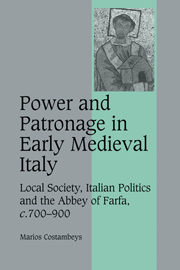 Power and Patronage in Early Medieval Italy
Power and Patronage in Early Medieval Italy Book contents
- Frontmatter
- Contents
- List of illustrations
- Acknowledgements
- Note on charter editions
- List of abbreviations
- Maps
- 1 INTRODUCTION
- 2 PATRONAGE AND LOMBARD RULERS
- 3 AUTHORITY, RULERSHIP AND THE ABBEY
- 4 THE MONKS AND ABBOTS OF FARFA: IDENTITIES AND AFFILIATIONS
- 5 SABINE LANDS AND LANDOWNERS
- 6 ELITE FAMILIES IN THE SABINA
- 7 FARFA AND ITALIAN POLITICS IN THE LOMBARD ERA
- 8 FARFA, ITALIAN POLITICS AND THE CAROLINGIANS
- Bibliography
- Index
- Cambridge Studies in Medieval Life and ThoughtFourth Series
5 - SABINE LANDS AND LANDOWNERS
Published online by Cambridge University Press: 17 July 2009
- Frontmatter
- Contents
- List of illustrations
- Acknowledgements
- Note on charter editions
- List of abbreviations
- Maps
- 1 INTRODUCTION
- 2 PATRONAGE AND LOMBARD RULERS
- 3 AUTHORITY, RULERSHIP AND THE ABBEY
- 4 THE MONKS AND ABBOTS OF FARFA: IDENTITIES AND AFFILIATIONS
- 5 SABINE LANDS AND LANDOWNERS
- 6 ELITE FAMILIES IN THE SABINA
- 7 FARFA AND ITALIAN POLITICS IN THE LOMBARD ERA
- 8 FARFA, ITALIAN POLITICS AND THE CAROLINGIANS
- Bibliography
- Index
- Cambridge Studies in Medieval Life and ThoughtFourth Series
Summary
INTRODUCTION
An appreciation of the motives and impact of the patronage of Farfa requires that we deal not only with the abbey's relations with formalized authorities, but also with patronage that originated in the ownership or tenure of land: ‘private’ property, to use an anachronistic but recognizable phrase. It has to be admitted straight away that to separate ‘private’ activity from that attached to ‘public’ organs of government is to make a distinction for hermeneutic convenience. The extent to which there was anything resembling such a distinction in early medieval societies is highly debatable. Certainly, we can agree with Matthew Innes that ‘we should avoid assuming that modern understandings of public and private translate unproblematically into the early medieval world’ that it is anachronistic to see the aim of rulers as the creation of a bureaucratized ‘state’, or that of private individuals as being to subvert, bypass or overcome that state. Roman law provided some public/private distinctions that carried over into the language of early medieval charters, and early medieval rulers were sometimes keen to promote a notion of the public as the domain of their authority. But in more fundamental ways the two mapped on to each other: we have seen how dependent the exercise of ‘public’ authority was on the attitudes of ‘private’ individuals and groups; landownership, on the other hand, can be seen as a firmly public matter since, as will be argued here, it itself both empowered and necessitated action in public.
- Type
- Chapter
- Information
- Power and Patronage in Early Medieval ItalyLocal Society, Italian Politics and the Abbey of Farfa, c.700–900, pp. 164 - 224Publisher: Cambridge University PressPrint publication year: 2007


